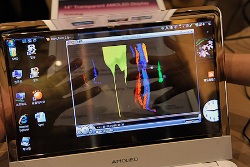AMOLED displays provide higher refresh rates than passive-matrix,[not specific enough to verify] often reducing the response time to less than a millisecond, and they consume significantly less power. This advantage makes active-matrix OLEDs well-suited for portable electronics, where power consumption is critical to battery life.
The amount of power the display consumes varies significantly depending on the color and brightness shown. As an example, one commercial QVGA OLED display consumes 0.3 watts while showing white text on a black background, but more than 0.7 watts showing black text on a white background, while an LCD may consume only a constant 0.35 watts regardless of what is being shown on screen. Because the black pixels actually turn off, AMOLED also has contrast ratios that are significantly better than LCD.[citation needed]
AMOLED displays may be difficult to view in direct sunlight compared with LCDs because of their reduced maximum brightness. Samsung’s Super AMOLED technology addresses this issue by reducing the size of gaps between layers of the screen. Additionally, PenTile technology is often used for a higher resolution display while requiring fewer subpixels than needed otherwise, sometimes resulting in a display less sharp and more grainy than a non-pentile display with the same resolution.
The organic materials used in AMOLED displays are very prone to degradation over a relatively short period of time, resulting in color shifts as one color fades faster than another, image persistence, or burn-in. Current demand for AMOLED screens is high, and, due to supply shortages of the Samsung-produced displays, certain models of HTC smartphones have been changed to use next-generation LCD displays from the Samsung-Sony joint-venture SLCD in the future.
Flagship smartphones sold as of 2011–12 use either Super AMOLED or IPS panel premium LCD. Super AMOLED displays, such as the one on the Galaxy Nexus and Samsung Galaxy S III have often been compared to IPS panel premium LCDs, found in the iPhone 4S, HTC One X, and Nexus 4. For example, according to ABI Research the AMOLED display found in the Motorola Moto X draws just 92 mA during bright conditions and 68 mA while dim. On the other hand, compared with the IPS, the yield rate of AMOLED is low, the cost is also higher.Super AMOLED is Samsung’s term for an AMOLED display with an integrated digitizer: the layer that detects touch is integrated into the screen, rather than overlaid on top of it. According to Samsung, Super AMOLED reflects one-fifth as much sunlight compared to the first generation AMOLED. The display technology itself is not changed. Super AMOLED is part of the Pentile matrix family, sometimes abbreviated as SAMOLED. For the Samsung Galaxy S III, which reverted to Super AMOLED instead of the pixelation-free conventional RGB (non-PenTile) Super AMOLED Plus of its predecessor Samsung Galaxy S II, the S III’s larger screen size encourages users to hold the phone further from their face to obscure the PenTile effect.
